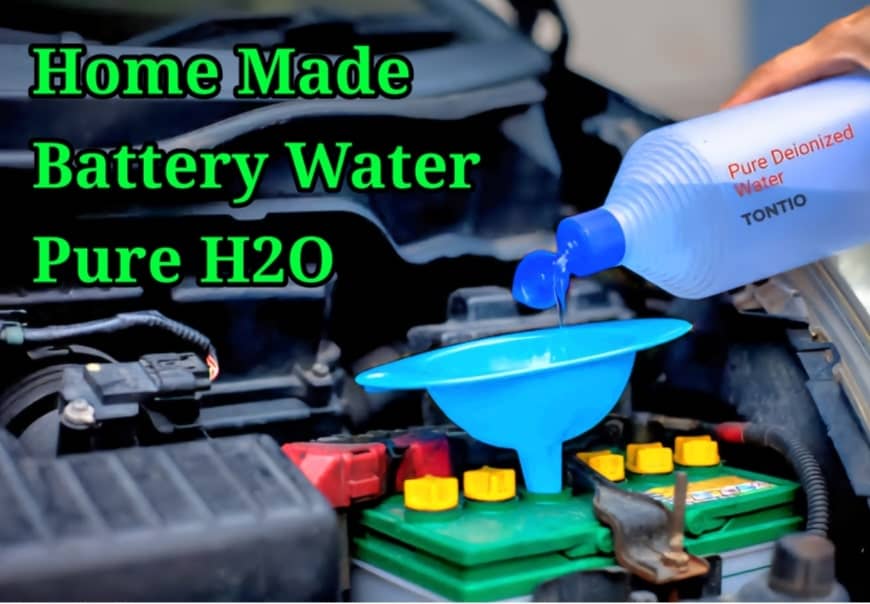Batteries power our cars, gadgets, and even backup systems. But did you know that the water inside some batteries (like lead-acid batteries) plays a big role in keeping them alive? Using the wrong type of water can damage your battery. This guide will teach you how to make battery water at home safely, explain its history, and answer common questions. Let’s dive in!
What Is Battery Water?
Battery water is distilled water—pure H₂O without minerals, chemicals, or impurities. Tap water contains minerals like calcium and magnesium, which can clog battery plates and reduce efficiency. Distilled water keeps batteries working smoothly by allowing proper chemical reactions.
History of Battery Water
Lead-acid batteries, invented in 1859 by French physicist Gaston Planté, were the first rechargeable batteries. Back then, people used rainwater or boiled water to fill batteries. Over time, engineers realized impurities in water caused battery failure. By the 1920s, distilled water became the standard for batteries. Today, it’s still essential for car batteries, solar systems, and industrial equipment.
Why You Can’t Use Regular Water?
- Minerals in tap water create deposits on battery plates, reducing lifespan.
- Impurities cause overheating and slow charging.
- Distilled water ensures only pure water interacts with battery acid (sulfuric acid).
Do you want to know how to make Dry Ice at home?
How to Make Battery Water at Home
You’ll need basic kitchen tools and patience. Here are three easy methods:
Method 1: Stovetop Distillation
What You Need:
- A large pot with a lid
- A heat-resistant bowl
- Ice cubes
- Water
Steps:
- Fill the pot halfway with tap water.
- Place the bowl inside the pot. It should float, not touch the bottom.
- Turn the lid upside down and cover the pot.
- Boil the water on medium heat. As steam rises, it’ll hit the cold lid, turn into droplets, and fall into the bowl.
- Add ice on the lid to speed up condensation.
- After 30–45 minutes, turn off the heat. The water in the bowl is distilled!
Method 2: DIY Solar Still (How to Make Lead-Acid Battery Water)
What You Need:
- A plastic sheet
- A container
- A rock
Steps:
- Dig a hole in a sunny spot and place the container in the center.
- Fill the hole with damp soil or plants.
- Cover the hole with the plastic sheet and place a rock in the center to create a dip.
- Sunlight evaporates water from the soil. Condensation collects on the plastic and drips into the container.
- Collect distilled water after 1–2 days.
Method 3: Using Two Bottles
What You Need:
- Two plastic bottles
- A tube (or rolled-up foil)
Steps:
- Cut one bottle in half. Fill the bottom with tap water.
- Invert the top half into the bottom half to create a funnel.
- Connect the second bottle to the funnel with a tube.
- Place the setup in sunlight. Evaporated water will collect in the second bottle.

Testing Your Homemade Battery Water
To ensure purity:
- Use a TDS (Total Dissolved Solids) meter. Pure distilled water reads 0–2 ppm.
- Let a drop dry on a glass. No white spots = no minerals.
How to Use Battery Water Safely
- Wear gloves and goggles to protect against battery acid.
- Only add water to a fully charged battery.
- Fill cells until plates are covered, but don’t overfill.
Common Mistakes to Avoid
- Using boiled tap water (it still has minerals).
- Adding water to a discharged battery (causes overflow).
- Storing distilled water in dirty containers.

Other Uses for Distilled Water
- Medical equipment (like CPAP machines).
- Steam irons (prevents clogging).
- Watering plants (avoids mineral buildup).
FAQs:
1. Can I use rainwater instead of distilled water?
Rainwater is better than tap water but may contain pollutants. Filter and boil it first.
2. How often should I check battery water levels?
Check every 2–3 months. Top up if levels drop below the plates.
3. Can I drink homemade distilled water?
Yes, but it lacks minerals. Don’t drink water from a battery!
4. What happens if I use tap water in my battery?
Minerals form sludge, reduce efficiency, and can kill the battery.
5. Can I buy distilled water instead?
Yes! It’s cheap at grocery stores or gas stations.
6. How long does homemade battery water last?
Store in a clean, sealed container. It lasts indefinitely.
7. Why does my battery water turn black?
It means the battery is corroding or overcharged. Get it checked.
8. Is distilled water the same as deionized water?
No. Deionized water removes ions but may still have impurities.
Pro Tips
- Label homemade distilled water clearly.
- Keep batteries clean and corrosion-free.
- Recycle old batteries responsibly.
By making your own battery water, you save money and keep your batteries healthy. Share this guide with friends to spread the knowledge!
Got more questions? Drop them in the comments below!

One thought on “How to Make Battery Water at Home: A Complete Guide”